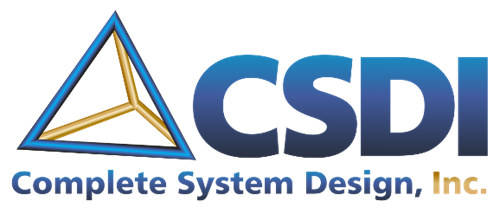75 S. Main Street 7-298
Concord
NH 03301
Office: 603-369-4499
Email: info@csdi.com
Analysis and Design is a vast subject. Here we will cover some basic topics that distinguish Complete System Design, Inc. (CSDI) from other cloud providers.
Cloud services are so accessible and inexpensive that it is tempting to skip this step. And sometimes that's OK. If you need to fix up a picture using Photoshop on Adobe's Creative Cloud, no analysis or design is needed. CSDI adds little value to that service implementation.
But, let's say that that you want to start using Office 365. You could just take out your credit card and get a subscription. But what about your CRM system? Will you have a separate user account for that? Then there is access to the database. Who should be able to access that data? How do you tell who the users are and what data they should be able to see? Back in the CRM system, are we going to let sales people access and possibly poach each other's prospects?
Analysis attempts to anticipate and answer all of these questions.
Inadequate analysis is the primary reason systems projects fail.
While there is volumes to read on this topic, two are covered here: Intake, Scope, and Responsibility.
Many systems IT shops require that requests be complete and presented on the "right form". Thus demanding that requesters anticipate all of the impacts the request.
That approach does not work. CSDI uses a System Request form. It is a blank page and customers fill it out as well as they can. Our intake process will create the request (or requests) in the correct format. If the customer knows the right format for the request, that saves time and expense. Complete analysis is not required for making a request.
However, categorizing the request is the first and a vital step. Some analysis is required.
Clients sometimes make requests that don't make business sense. If our mission was simply to move software product, we would applaud such requests. However, our purpose is to ensure client success. To do that, we must understand the underlying business rationale.
Clients often don't know the ramifications implicit in the request. Technicians frequently do not know the business well enough to ensure all the needed functionality is included in the design. Clarification of requirements and the business context requires careful communications. Our providers and a client agree to a mutual contract. Providers do not accept a requirement as complete until the provider is convinced that the description is complete and unambiguous enough that the system the customer needs can be built. Similarly, the client agrees to be forthcoming with business process information and design requirements. In addition, the client agrees to review design documents and verify that the provider has understood their needs.
It is not always apparent how much work is required to satisfy a request. Our process requires that the analysis be completed before we begin work on a project. After the analysis, a plan is assembled and estimates are provided. Some high-level decisions must be made in order to develop a project plan and estimate the scope of the work. Project estimates prior to high-level design and planning are not useful. This is the point where the client can decide if they want to continue the project, reduce scale, or cancel continued work.
Clients play an important role in design. In analysis review, we confirm that the project team understands the needed functionality. The design documents demonstrate that the system will work the way the client wants it to. This step is important, but frequently overlooked. There are a number of ways to do this. On smaller projects, prototyping may be valid. CSDI projects are frequently organized into "sprints" where the most important functionality is developed first. Clients are invited to attend daily meetings so they always know where the project stands and what design decisions have been made. Client participation in design reviews is essential.
The number of analysis and design steps will vary from project to project. The need for collaboration does not change, however. It is the responsibility of CSDI and our providers to ensure the client has a clear picture of how we view the business needs and how the new system will function. Clients are responsible for communicating business needs and reviewing requirements and design documents.
System implementation does not commence until the plans are approved, just as plan approval precedes construction of a building.
System design is a collaborative effort. When that fact is fully understood, great work can be done.
In order to change an existing paradigm you do not struggle to try and change the problematic model. You create a new model and make the old one obsolete.
R. Buckminster Fuller
